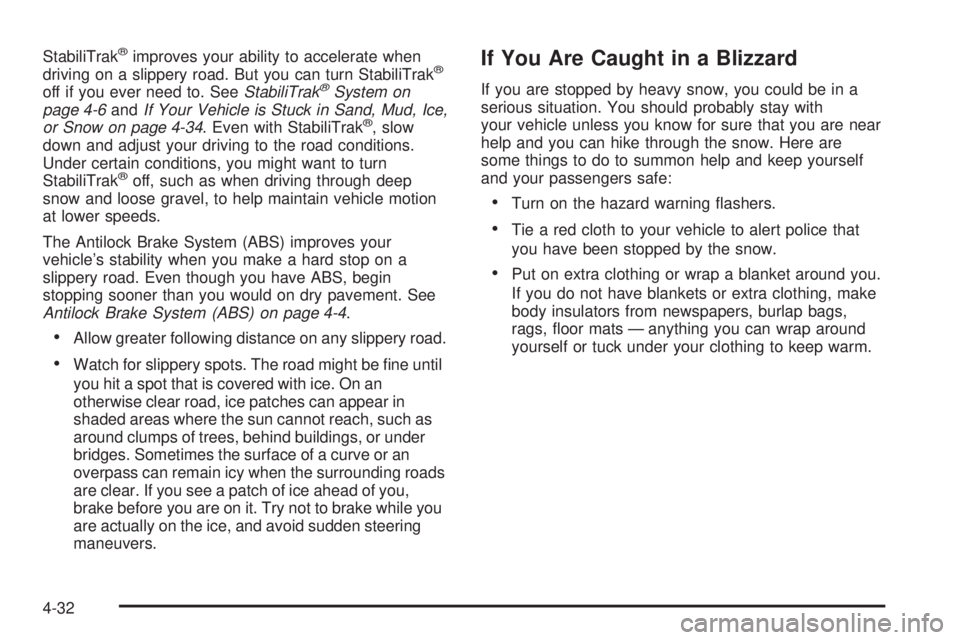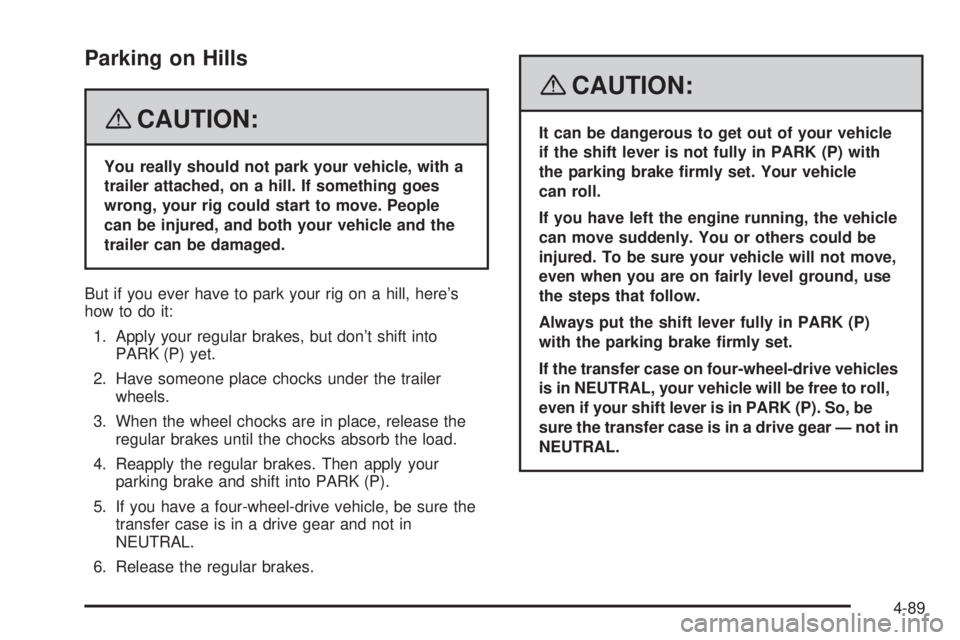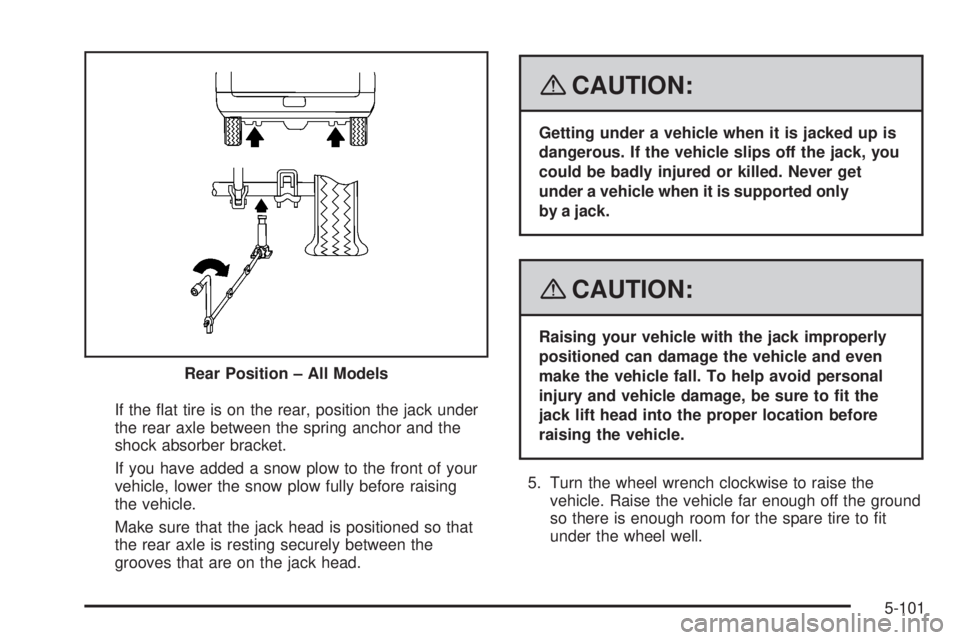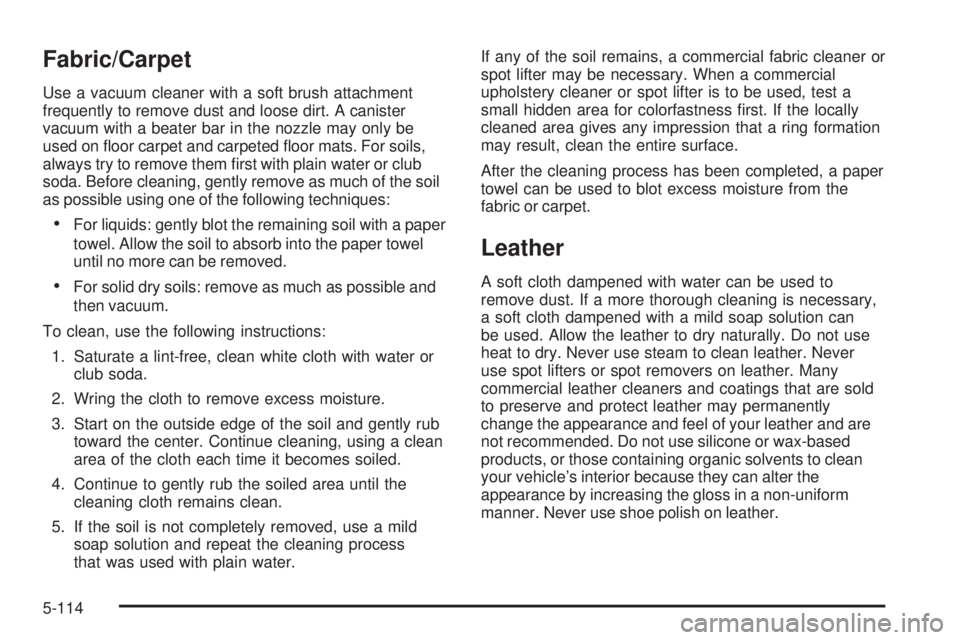2008 GMC SIERRA ABS
[x] Cancel search: ABSPage 330 of 578

StabiliTrak®improves your ability to accelerate when
driving on a slippery road. But you can turn StabiliTrak®
off if you ever need to. SeeStabiliTrak®System on
page 4-6andIf Your Vehicle is Stuck in Sand, Mud, Ice,
or Snow on page 4-34. Even with StabiliTrak
®, slow
down and adjust your driving to the road conditions.
Under certain conditions, you might want to turn
StabiliTrak
®off, such as when driving through deep
snow and loose gravel, to help maintain vehicle motion
at lower speeds.
The Antilock Brake System (ABS) improves your
vehicle’s stability when you make a hard stop on a
slippery road. Even though you have ABS, begin
stopping sooner than you would on dry pavement. See
Antilock Brake System (ABS) on page 4-4.
Allow greater following distance on any slippery road.
Watch for slippery spots. The road might be �ne until
you hit a spot that is covered with ice. On an
otherwise clear road, ice patches can appear in
shaded areas where the sun cannot reach, such as
around clumps of trees, behind buildings, or under
bridges. Sometimes the surface of a curve or an
overpass can remain icy when the surrounding roads
are clear. If you see a patch of ice ahead of you,
brake before you are on it. Try not to brake while you
are actually on the ice, and avoid sudden steering
maneuvers.
If You Are Caught in a Blizzard
If you are stopped by heavy snow, you could be in a
serious situation. You should probably stay with
your vehicle unless you know for sure that you are near
help and you can hike through the snow. Here are
some things to do to summon help and keep yourself
and your passengers safe:
Turn on the hazard warning �ashers.
Tie a red cloth to your vehicle to alert police that
you have been stopped by the snow.
Put on extra clothing or wrap a blanket around you.
If you do not have blankets or extra clothing, make
body insulators from newspapers, burlap bags,
rags, �oor mats — anything you can wrap around
yourself or tuck under your clothing to keep warm.
4-32
Page 387 of 578

Parking on Hills
{CAUTION:
You really should not park your vehicle, with a
trailer attached, on a hill. If something goes
wrong, your rig could start to move. People
can be injured, and both your vehicle and the
trailer can be damaged.
But if you ever have to park your rig on a hill, here’s
how to do it:
1. Apply your regular brakes, but don’t shift into
PARK (P) yet.
2. Have someone place chocks under the trailer
wheels.
3. When the wheel chocks are in place, release the
regular brakes until the chocks absorb the load.
4. Reapply the regular brakes. Then apply your
parking brake and shift into PARK (P).
5. If you have a four-wheel-drive vehicle, be sure the
transfer case is in a drive gear and not in
NEUTRAL.
6. Release the regular brakes.
{CAUTION:
It can be dangerous to get out of your vehicle
if the shift lever is not fully in PARK (P) with
the parking brake �rmly set. Your vehicle
can roll.
If you have left the engine running, the vehicle
can move suddenly. You or others could be
injured. To be sure your vehicle will not move,
even when you are on fairly level ground, use
the steps that follow.
Always put the shift lever fully in PARK (P)
with the parking brake �rmly set.
If the transfer case on four-wheel-drive vehicles
is in NEUTRAL, your vehicle will be free to roll,
even if your shift lever is in PARK (P). So, be
sure the transfer case is in a drive gear — not in
NEUTRAL.
4-89
Page 493 of 578

If the �at tire is on the rear, position the jack under
the rear axle between the spring anchor and the
shock absorber bracket.
If you have added a snow plow to the front of your
vehicle, lower the snow plow fully before raising
the vehicle.
Make sure that the jack head is positioned so that
the rear axle is resting securely between the
grooves that are on the jack head.
{CAUTION:
Getting under a vehicle when it is jacked up is
dangerous. If the vehicle slips off the jack, you
could be badly injured or killed. Never get
under a vehicle when it is supported only
by a jack.
{CAUTION:
Raising your vehicle with the jack improperly
positioned can damage the vehicle and even
make the vehicle fall. To help avoid personal
injury and vehicle damage, be sure to �t the
jack lift head into the proper location before
raising the vehicle.
5. Turn the wheel wrench clockwise to raise the
vehicle. Raise the vehicle far enough off the ground
so there is enough room for the spare tire to �t
under the wheel well. Rear Position – All Models
5-101
Page 506 of 578

Fabric/Carpet
Use a vacuum cleaner with a soft brush attachment
frequently to remove dust and loose dirt. A canister
vacuum with a beater bar in the nozzle may only be
used on �oor carpet and carpeted �oor mats. For soils,
always try to remove them �rst with plain water or club
soda. Before cleaning, gently remove as much of the soil
as possible using one of the following techniques:
For liquids: gently blot the remaining soil with a paper
towel. Allow the soil to absorb into the paper towel
until no more can be removed.
For solid dry soils: remove as much as possible and
then vacuum.
To clean, use the following instructions:
1. Saturate a lint-free, clean white cloth with water or
club soda.
2. Wring the cloth to remove excess moisture.
3. Start on the outside edge of the soil and gently rub
toward the center. Continue cleaning, using a clean
area of the cloth each time it becomes soiled.
4. Continue to gently rub the soiled area until the
cleaning cloth remains clean.
5. If the soil is not completely removed, use a mild
soap solution and repeat the cleaning process
that was used with plain water.If any of the soil remains, a commercial fabric cleaner or
spot lifter may be necessary. When a commercial
upholstery cleaner or spot lifter is to be used, test a
small hidden area for colorfastness �rst. If the locally
cleaned area gives any impression that a ring formation
may result, clean the entire surface.
After the cleaning process has been completed, a paper
towel can be used to blot excess moisture from the
fabric or carpet.
Leather
A soft cloth dampened with water can be used to
remove dust. If a more thorough cleaning is necessary,
a soft cloth dampened with a mild soap solution can
be used. Allow the leather to dry naturally. Do not use
heat to dry. Never use steam to clean leather. Never
use spot lifters or spot removers on leather. Many
commercial leather cleaners and coatings that are sold
to preserve and protect leather may permanently
change the appearance and feel of your leather and are
not recommended. Do not use silicone or wax-based
products, or those containing organic solvents to clean
your vehicle’s interior because they can alter the
appearance by increasing the gloss in a non-uniform
manner. Never use shoe polish on leather.
5-114
Page 565 of 578

A
Accessories and Modi�cations............................ 5-4
Adding a Snow Plow or Similar Equipment.........4-43
Adding Equipment to Your Airbag-Equipped
Vehicle.......................................................1-85
Additives, Fuel................................................. 5-7
Add-On Electrical Equipment...........................5-122
Adjustable Throttle and Brake Pedal..................2-26
Air Cleaner/Filter, Engine.................................5-19
Air Conditioning..............................3-25, 3-27, 3-28
Airbag
Off Light.....................................................3-39
Passenger Status Indicator...........................3-41
Readiness Light..........................................3-38
Airbag System................................................1-68
What Will You See After an Airbag In�ates?....1-75
When Should an Airbag In�ate?....................1-73
Where Are the Airbags?...............................1-71
Airbag Systems
Adding Equipment to Your Airbag-Equipped
Vehicle...................................................1-85
Airbag Off Switch........................................1-76
How Does an Airbag Restrain?......................1-74
Passenger Sensing System...........................1-80
Servicing Your Airbag-Equipped Vehicle..........1-84
What Makes an Airbag In�ate?......................1-74
Antenna, Fixed Mast......................................3-126Antenna, XM™ Satellite Radio Antenna
System.....................................................3-126
Antilock Brake System (ABS)............................. 4-4
Antilock Brake, System Warning Light................3-45
Appearance Care
Aluminum or Chrome-Plated Wheels.............5-118
Care of Safety Belts...................................5-115
Chemical Paint Spotting..............................5-120
Cleaning Exterior Lamps/Lenses..................5-116
Fabric/Carpet............................................5-114
Finish Care...............................................5-116
Finish Damage..........................................5-119
Instrument Panel, Vinyl, and Other Plastic
Surfaces
...............................................5-115
Interior Cleaning........................................5-112
Leather....................................................5-114
Sheet Metal Damage..................................5-119
Tires........................................................5-119
Underbody Maintenance.............................5-119
Vehicle Care/Appearance Materials...............5-120
Washing Your Vehicle.................................5-116
Weatherstrips............................................5-115
Windshield and Wiper Blades......................5-117
Appointments, Scheduling Service....................... 7-9
Ashtray.........................................................3-24
Audio System.................................................3-80
Audio Steering Wheel Controls....................3-124
Fixed Mast Antenna...................................3-126
1